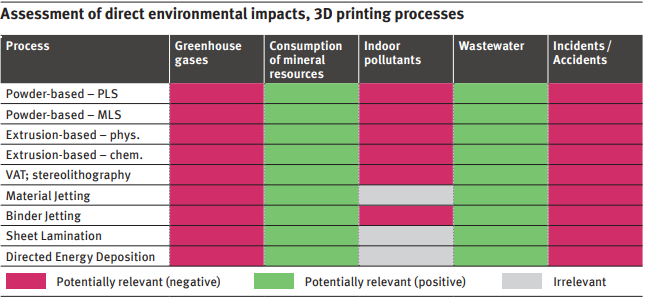A recent study by German environmental association, Umweltbundesamt (UBA), gives information on 3D printing and the environment. Titled 3D Printing Trend report for assessing the environmental impacts, this study details the burdens and benefits of additive manufacturing within the environment, and its impact on personal health at home and in factories.
The UBA
Founded in 1974, the UBA acts as Germany’s main environmental protection agency. At present, the association employs an estimated 1600 workers across 13 sites, including biologists, chemists, economists, lawyers and engineers from all ecology related disciplines.
The main goal of the UBA is to examine environmental issues from all sides to develop viable solutions based on its findings and providing federal bodies such as the Ministry of the Environment with policy advice.
Although there have been various eco-friendly 3D printing projects such as NNSA’s 3D printed beads that capture carbon dioxide and Rotterdam Zoo’s initiative for reef conservation through 3D printed ceramic coral seeing units, according to UBA, 3D printing itself has also contributed to pollution.
The positives and the negatives
Taking into account the different elements of 3D printing, that is, materials, technologies, and industrial supportive services, this report has analyzed the text of 987 studies relating to 3D printing. Using a qualitative content analysis software, the study aimed to identify current and future trends regarding environmental impact.
As a result, under the direct environmental impacts, the study argues that 3D printing has contributed negatively to greenhouse gas emissions due to its energy demands.
The chart below shows various 3D printing processes, and the suspected impact each one will have/is having on the environment. All listed process, the majority of which use plastic feedstocks, are estimated to be contributing negatively to greenhouse gases. In terms of mineral resource consumption however, each process is deemed as having a potentially positive effect.
The advantages and disadvantages here could potentially cancel each other out, but from qualitative analysis alone it is hard to tell.

What is the danger?
Airborne matter, such as volatile organic compounds (VOCs) nanoparticles and solvents, are correctly pointed out in the UBA as harmful bi-products of the melting process, which can result in “accidents” when managed by “unskilled persons.”
The impact of this airborne matter, however, is not something that should be new to 3D printer users. Findings from a two-year investigative report from UL, a global safety science organization, concluded that exposure to particles and VOC emissions produced by 3D printing processes are generally low when applying appropriate precautions, e.g. working in a well ventilated, using 3D printers with air filters.
And so, generally speaking, with common sense applied 3D printing is safe.
Greener 3D printing in construction
The UBA study also concedes on the potential positive impact 3D printing could have on the construction industry. As reported on page 33 of the paper:
“Under certain conditions, in situ printing of building parts may be more eco-friendly in terms of resource consumption than conventional construction processes because no craning of components is required and complex geometries are easier to implement.”
“Major positive environmental impacts can be expected because the amount of materials used in the building industry is generally very large. However, it has to be taken into account that in the foreseeable future the advantages of 3D printing will become most relevant for complex objects where only one material is used.”
However, the authors point out, that 3D printing construction processes still need to be sufficiently understood and developed.

The benefits, burdens, and potential policies
The UBA study concludes by summarizing the major advantage of the increased use of 3D printing technologies: streamlined, energy-efficient production processes for both businesses and creative individuals. However, the study calls for action to be taken to raise awareness of worker’s health risks while taking advantage of new manufacturing opportunities.
“There is a need for environmental policy to take action. The reasons for this include both the risks identified in this report, which have to be minimized, but also to the (environmental) opportunities, which would need political support because they are not implemented all by themselves.”
The 3D printing industry is, of course, taking such important steps. UL recently introduced a certificate for the safety of powder handling in additive manufacturing, helping industrial users of the materials and machines work hazard-free.
Documents, such as the America Makes & ANSI Additive Manufacturing Standardization Collaborative (AMSC) roadmap also endeavor to identify and fill the gaps in 3D printing certification and qualification.
Stay updated with 3D printer safety by subscribing to the 3D Printing Industry newsletter. Also, follow us on Twitter, and like us on Facebook.
Looking for a change of pace? Seeking new talent for your business? Search and post 3D Printing Jobs for opportunities and new talent across engineering, marketing, sales and more.
Featured image shows a grass house. Photo via Coverd.


